
Browse an alphabetical list of photographs. These historical images portray people, places, and events before, during, and after World War II and the Holocaust.
<< Previous | Displaying results 751-773 of 2641 for "Photo" | Next >>
German troops view the burning of a village in the Rogachyevo district of Gomel, Belarus, 1941.
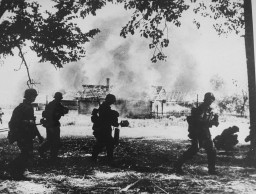
Following the German invasion of Poland on September 1, 1939, Warsaw suffered heavy air attacks and artillery bombardment. German troops entered the city on September 29, shortly after its surrender. This photograph was taken by Julien Bryan, an American documentary filmmaker who captured the German bombardment and its impact on the Polish citizenry. Warsaw, Poland, ca. 1939.
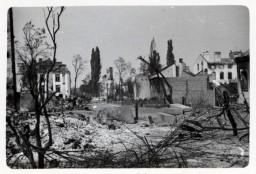
The damaged lintel above a Torah ark from a synagogue that was destroyed during Kristallnacht. Nentershausen, Germany, 1938.
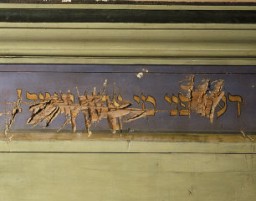
SS officers stand among the rubble of Lidice during the demolition of the town's ruins in reprisal for the assasination of Reinhard Heydrich. Czechoslovakia, between June 10 and June 30, 1942.
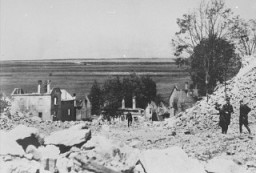
Destruction of the Dortmund synagogue during Kristallnacht (the "Night of Broken Glass"). Germany, November 1938.
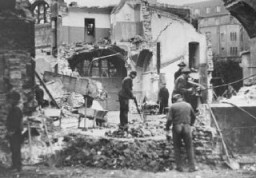
Dietrich Bonhoeffer, German Protestant theologian who was executed in the Flossenbürg concentration camp on April 9, 1945. Germany, date uncertain.
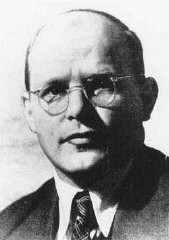
A US flag hangs from the ceiling of the main dining room at the Landsberg displaced persons camp. Germany, December 6, 1945.

Diploma issued by the International Refugee Organization (IRO) certifying that Naftali Froimowicz was trained as a shoemaker in Turin, Italy on November 14, 1949. Froimowicz lived in several displaced persons (DP) camps in Italy after the war.
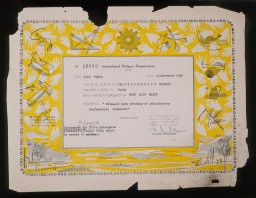
A Jewish refugee couple poses on the gangway of the MS St. Louis as they disembark from the ship in Antwerp. Belgium, June 17, 1939.
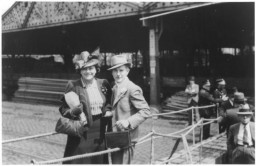
Displaced Iraqis wait for food distribution at an internally displaced persons (IDP) camp on the outskirts of Erbil, Iraqi Kurdistan. September 2, 2015.
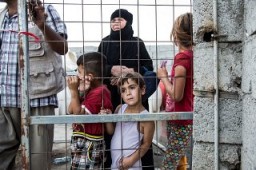
Displaced persons stand on a train platform in the weeks after the end of World War II in Europe. Kolleda, Germany, June 1945.
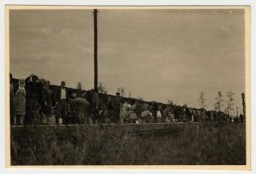
Displaced persons knitting and embroidering at a camp administered by the United Nations Relief and Rehabilitation Administration (UNRRA). Sweden, after May 1945.
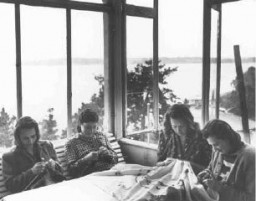
Jewish displaced persons (DPs) converse on the streets of the Neu Freimann DP camp, circa 1946–1948.The photographer, Jack Sutin, lived at the camp with his family and worked as a camp administrator and photojournalist.
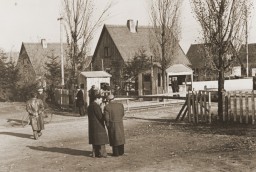
View of a displaced persons camp in Salzburg, in the American occupation zone. Salzburg, Austria, May 25, 1945.
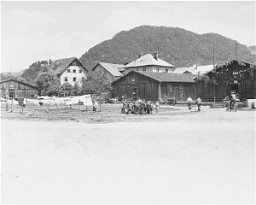
A man and his son, displaced persons (DPs) from Romania, wait on a cot in the Rothschild Hospital displaced persons camp in Vienna. Austria, October 15, 1947.

Displaced persons wait next to their suitcases and bundles, place uncertain, ca. 1947.

Assembly point for Poles displaced by the German Race and Resettlement Main Office (RuSHA). Sol, Poland, September 24, 1940.
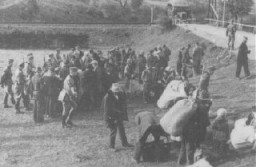
A display, entitled "British Freemasonry," at an antisemitic and anti-Masonic exhibition in Berlin. The display shows a Torah scroll and a picture of King Edward bearing Masonic regalia. Berlin, Germany, March 7, 1941.
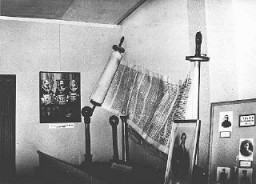
Display from "Der ewige Jude" (The Eternal Jew), a Nazi antisemitic exhibit which claimed that Jews heavily dominated the German performing arts. A phrase at the top of the display states "Shameless Entertainment." Berlin, Germany, November 11, 1938.
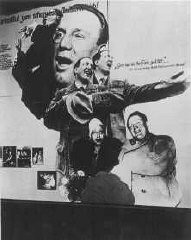
A Hochheim parade float proceeds down the Kirchstrasse, passing by a display box for Der Stürmer, an antisemitic newspaper. The display box bears the slogan, "Without a solution to the Jewish question, there is no salvation for the German people." Hochheim am Main, Germany, circa 1934–1940.
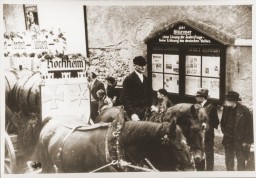
Djakovo camp, where Croatian Jews were imprisoned and killed, was located in this former flour mill. Yugoslavia, wartime.
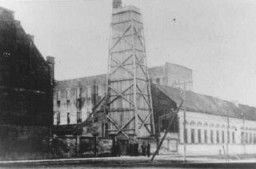
Document issued by the Regional Agricultural Mercantile Cooperative in Busko-Zdroj certifying that Bronislawa Tymejko (the false identity of Sophie Schwarzwald's mother, Laura Schwarzwald) was employed by the cooperative, dated November 1942.
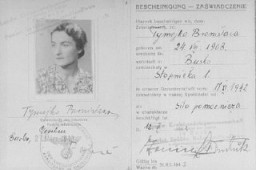
View of the mimeograph room in the Palace of Justice at Nuremberg after the transcripts on the sentencing of the defendants in the High Command Case had been run off. The reproduction of documents during the Nuremberg trials, often in four languages, was a huge logistical challenge. Nuremberg, Germany, 1948. (Source record ID: A65III/RA-121-D)
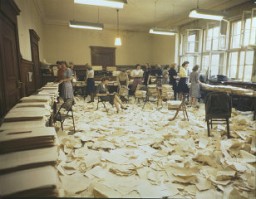
We would like to thank Crown Family Philanthropies, Abe and Ida Cooper Foundation, the Claims Conference, EVZ, and BMF for supporting the ongoing work to create content and resources for the Holocaust Encyclopedia. View the list of donor acknowledgement.